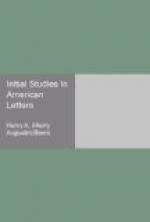When Irving returned to America, in 1832, he was the recipient of almost national honors. He had received the medal of the Royal Society of Literature and the degree of D.C.L. from Oxford University, and had made American literature known and respected abroad. In his modest home at Sunnyside, on the banks of the river over which he had been the first to throw the witchery of poetry and romance, he was attended to the last by the admiring affection of his countrymen. He had the love and praises of the foremost English writers of his own generation and the generation which followed—of Scott, Byron, Coleridge, Thackeray, and Dickens, some of whom had been among his personal friends. He is not the greatest of American authors, but the influence of his writings is sweet and wholesome, and it is in many ways fortunate that the first American man of letters who made himself heard in Europe should have been in all particulars a gentleman.
Connected with Irving, at least by name and locality, were a number of authors who resided in the city of New York, and who are known as the Knickerbocker writers, perhaps because they were contributors to the Knickerbocker Magazine. One of these was James K. Paulding, a connection of Irving by marriage, and his partner in the Salmagundi papers. Paulding became Secretary of the Navy under Van Buren, and lived down to the year 1860. He was a voluminous author, but his writings had no power of continuance, and are already obsolete, with the possible exception of his novel, the Dutchman’s Fireside, 1831.
A finer spirit than Paulding was Joseph Rodman Drake, a young poet of great promise, who died in 1820, at the age of twenty-five. Drake’s patriotic lyric, the American Flag, is certainly the most spirited thing of the kind in our poetic literature, and greatly superior to such national anthems as Hail Columbia and the Star-Spangled Banner. His Culprit Fay, published in 1819, was the best poem that had yet appeared in America, if we except Bryant’s Thanatopsis, which was three years the elder. The Culprit Fay was a fairy story, in which, following Irving’s lead, Drake undertook to throw the glamour of poetry about the Highlands of the Hudson. Edgar Poe said that the poem was fanciful rather than imaginative; but it is prettily and even brilliantly fanciful, and has maintained its popularity to the present time. Such verse as the following—which seems to show that Drake had been reading Coleridge’s Christabel, published three years before—was something new in American poetry:
“The winds are whist and the owl
is still,
The bat in the shelvy rock
is hid,
And naught is heard on the lonely hill
But the cricket’s chirp
and the answer shrill
Of the gauze-winged katydid,
And the plaint of the wailing
whip-poor-will,
Who moans unseen, and ceaseless sings
Ever a note of wail and woe,
Till morning spreads her rosy wings,
And earth and sky in her glances
glow.”




